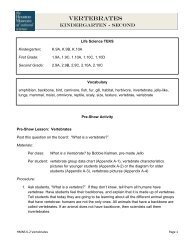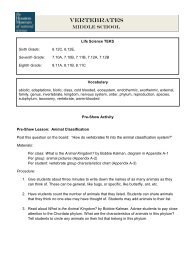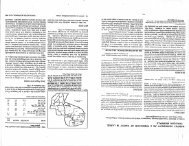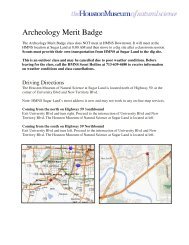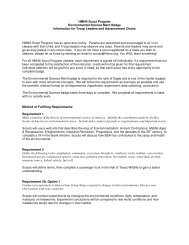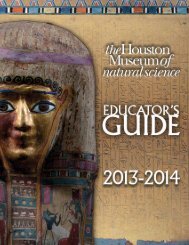Middle School - Houston Museum of Natural Science
Middle School - Houston Museum of Natural Science
Middle School - Houston Museum of Natural Science
Create successful ePaper yourself
Turn your PDF publications into a flip-book with our unique Google optimized e-Paper software.
A-4<br />
4. Carbonization: Sometimes s<strong>of</strong>t parts and/or hard parts <strong>of</strong> the body <strong>of</strong> an<br />
organism are compressed by burial before decomposition is complete. As a<br />
result, the volatile substances (such as oxygen, nitrogen, carbon dioxide,<br />
water, etc.) are squeezed out, leaving behind a film <strong>of</strong> fairly pure carbon.<br />
This is particularly common in the preservation plant fossils (such as ferns<br />
and leaves, and some invertebrates, but also occurs sometimes for<br />
vertebrates.<br />
5. Molds and Casts: Sometimes the hard parts (bone or other material), and<br />
sometimes even s<strong>of</strong>t tissue), <strong>of</strong> organisms are buried by sediment and<br />
remains until the sediment is hardened by compaction and cementation.<br />
Later, it is dissolved by acidic ground waters percolating through the pores<br />
<strong>of</strong> the rock or decomposed by other processes. This will leave an<br />
impression <strong>of</strong> the external body <strong>of</strong> the organism. This is called an external<br />
mold. If later the mold is filled in with mineral matter or sediment, a cast is<br />
formed which mimics the external body <strong>of</strong> the original material. Sometimes<br />
internal cavities <strong>of</strong> skeletons may be filled with sediment or mineral matter<br />
resulting in a mold <strong>of</strong> the internal body parts that were filled. This is called<br />
an internal mold.<br />
6. Organic Traps: Insects, spiders, and even small lizard have been found,<br />
nearly perfectly preserved in amber. Picture this scenario: A fly lands on a<br />
tree branch and is looking for food. It steps in sticky sap that the tree has<br />
made and is covered in the sap. The sap then hardens over time,<br />
becoming amber, and trapping the fly inside, preserving it.<br />
HMNS <strong>Middle</strong> <strong>School</strong> Focus on Fossils Page 12




